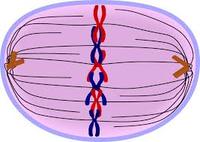
Understanding Cell Cycle and Mitosis
Quiz
•
Science
•
7th Grade
•
Practice Problem
•
Medium
Standards-aligned
Ethan Evans
Used 3+ times
FREE Resource
Enhance your content in a minute
10 questions
Show all answers
1.
MULTIPLE CHOICE QUESTION
30 sec • 1 pt
During which stage of mitosis do the chromosomes line up in the middle of the cell?
Prophase
Metaphase
Anaphase
Telophase
Answer explanation
During metaphase, chromosomes align at the cell's equatorial plane, ensuring they are properly positioned for separation. This is a key step before the chromosomes are pulled apart in anaphase.
2.
MULTIPLE CHOICE QUESTION
30 sec • 1 pt
Which of the following is a function of mitosis?
Production of gametes
Growth and repair of tissues
Exchange of genetic material
Reduction of chromosome number
Answer explanation
Mitosis is primarily responsible for the growth and repair of tissues by producing identical daughter cells. In contrast, gamete production occurs through meiosis, and the exchange of genetic material and reduction of chromosome number are also meiosis functions.
Tags
NGSS.HS-LS1-4
3.
MULTIPLE CHOICE QUESTION
30 sec • 1 pt
Why is cell division important for multicellular organisms?
It allows for the exchange of gases
It helps in the digestion of food
It enables growth and repair
It provides energy to cells
Answer explanation
Cell division is crucial for multicellular organisms as it enables growth and repair. Through this process, new cells are produced to replace damaged ones and to allow the organism to grow, ensuring proper function and health.
Tags
NGSS.MS-LS1-5
4.
MULTIPLE CHOICE QUESTION
30 sec • 1 pt
Describe what happens during anaphase of mitosis.
Chromosomes condense and become visible
Chromosomes align at the cell equator
Sister chromatids are pulled apart to opposite poles
Nuclear envelope re-forms around chromosomes
Answer explanation
During anaphase of mitosis, sister chromatids are pulled apart to opposite poles of the cell, ensuring that each new daughter cell will receive an identical set of chromosomes.
Tags
NGSS.HS-LS1-4
5.
MULTIPLE CHOICE QUESTION
30 sec • 1 pt
How does mitosis contribute to genetic stability?
By reducing the chromosome number by half
By ensuring each daughter cell receives an identical set of chromosomes
By allowing for genetic variation through crossing over
By producing genetically diverse cells
Answer explanation
Mitosis ensures genetic stability by producing two daughter cells that each receive an identical set of chromosomes from the parent cell. This process maintains the chromosome number and genetic information across generations.
Tags
NGSS.HS-LS1-4
6.
MULTIPLE CHOICE QUESTION
30 sec • 1 pt
Identify the phase of mitosis where the nuclear envelope breaks down.
Prophase
Metaphase
Anaphase
Telophase
Answer explanation
During prophase, the nuclear envelope breaks down, allowing the chromosomes to condense and become visible. This is a key event that prepares the cell for the subsequent stages of mitosis.
7.
MULTIPLE CHOICE QUESTION
30 sec • 1 pt
Which stage of mitosis is characterized by the reformation of the nuclear envelope?
Prophase
Metaphase
Anaphase
Telophase
Answer explanation
Telophase is the stage of mitosis where the nuclear envelope reforms around the separated sets of chromosomes, marking the near end of cell division.
Create a free account and access millions of resources
Create resources
Host any resource
Get auto-graded reports

Continue with Google

Continue with Email

Continue with Classlink

Continue with Clever
or continue with

Microsoft
%20(1).png)
Apple
Others
Already have an account?
Similar Resources on Wayground

13 questions
INTERACT GENERAL KNOWLEGE TRIVIA
Quiz
•
7th - 12th Grade

15 questions
Week 4 - Science 7
Quiz
•
7th Grade

11 questions
A1 Investigative skills 2
Quiz
•
5th - 9th Grade

15 questions
IS_Unit9_Checkpoint 9.2_E
Quiz
•
7th Grade

7 questions
Changes around us
Quiz
•
KG - Professional Dev...

15 questions
Classifying Matter
Quiz
•
6th - 8th Grade

12 questions
KSSM_FORM 4_CHAPTER 11_11.2
Quiz
•
1st - 12th Grade

12 questions
IS_Unit6_Checkpoint 6.3_E
Quiz
•
7th Grade
Popular Resources on Wayground

5 questions
This is not a...winter edition (Drawing game)
Quiz
•
1st - 5th Grade

15 questions
4:3 Model Multiplication of Decimals by Whole Numbers
Quiz
•
5th Grade

25 questions
Multiplication Facts
Quiz
•
5th Grade

10 questions
The Best Christmas Pageant Ever Chapters 1 & 2
Quiz
•
4th Grade

12 questions
Unit 4 Review Day
Quiz
•
3rd Grade

10 questions
Identify Iconic Christmas Movie Scenes
Interactive video
•
6th - 10th Grade

20 questions
Christmas Trivia
Quiz
•
6th - 8th Grade

18 questions
Kids Christmas Trivia
Quiz
•
KG - 5th Grade
Discover more resources for Science

20 questions
Convection, Conduction, and Radiation
Quiz
•
6th - 8th Grade

10 questions
Exploring the Energy Cycle: Photosynthesis and Cellular Respiration
Interactive video
•
6th - 10th Grade

22 questions
Rock Transformations Amplify Final Test
Quiz
•
6th - 8th Grade

20 questions
Human Body Systems Review
Quiz
•
7th Grade

10 questions
Exploring Plate Tectonics and Their Boundaries
Interactive video
•
6th - 10th Grade

10 questions
Understanding Moon Phases and Characteristics
Interactive video
•
5th - 8th Grade

20 questions
Energy Transformations
Quiz
•
6th - 8th Grade

10 questions
Exploring Light and Waves Concepts
Interactive video
•
6th - 10th Grade

